
Agapanthus africanus, or the African lily, is a flowering plant from the genus Agapanthus found only on rocky sandstone slopes of the winter rainfall fynbos from the Cape Peninsula to Swellendam. It is also known as the lily-of-the-Nile in spite of only occurring in South Africa.

Freesia is a genus of herbaceous perennial flowering plants in the family Iridaceae, first described as a genus in 1866 by Christian Friedrich Ecklon (1886) and named after the German botanist and medical practitioner, Friedrich Freese (1795-1876). It is native to the eastern side of southern Africa, from Kenya south to South Africa, most species being found in Cape Provinces. Species of the former genus Anomatheca are now included in Freesia. The plants commonly known as "freesias", with fragrant funnel-shaped flowers, are cultivated hybrids of a number of Freesia species. Some other species are also grown as ornamental plants.

Disa is a genus of flowering plants in the family Orchidaceae. It comprises about 182 species. Most of the species are indigenous to tropical and southern Africa, with a few more in the Arabian Peninsula, Madagascar, and Réunion. Disa bracteata is naturalised in Western Australia, where the local name is "African weed-orchid."

Euclea, from the Greek eukleia meaning "glory and fame", denotes a group of flowering plants in the Ebenaceae or ebony family. They were described as a genus by Linnaeus in 1774. The genus includes evergreen trees and shrubs, native to Africa, the Comoro Islands and Arabia. Several species are used for timber, producing a hard, dark heartwood timber similar to ebony.

Protea laurifolia, also known as the grey-leaf sugarbush, is a shrub from South Africa. It is native to the Cape Provinces of South Africa.

Disa cornuta is a species of orchid found from Zimbabwe to South Africa.

Disa draconis is a species of orchid found in South Africa.
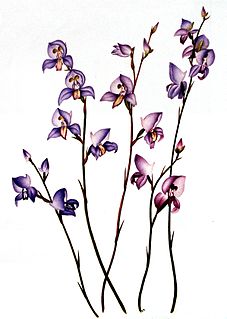
Disa purpurascens is a species of orchid found in South Africa. It is also known as the early blue disa or the bloumoederkappie.
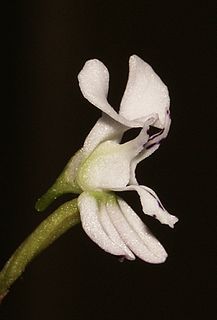
Disa sagittalis is a species of orchid found in South Africa from south and southeast Cape Province to southern KwaZulu-Natal.
Lachnospermum, common name rooiblombos, is a genus of South African flowering plants in the family Asteraceae.

Disa graminifolia is a species of orchid found in the Cape Floristic Region of South Africa.

Disa ferruginea is a stout, reed-like terrestrial 200–450 mm tall. Radical leaves linear, developing after flowering; cauline leaves dry, sheathing. Inflorescence dense, 1–40 flowered. Flowers bright red to orange, often with some parts yellow. Median sepal apiculate, galea 8–10 mm deep; spur slender, grading into the galea, 7–20 mm long; lateral sepals projecting away;elliptic to narrowly elliptic, with apiculi up to 4 mm long;petals spear-shaped, 5–7 mm long; lip narrowly egg- to spear-shaped, 10–12 mm long.
Graham Dugald Duncan(born 1959) is a South African botanist and specialist bulb horticulturalist at the Kirstenbosch National Botanical Garden, Cape Town, South Africa.
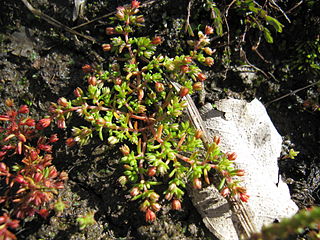
Crassula decumbens, commonly known as rufous stonecrop, cape crassula or spreading crassula, is a herb in the family Crassulaceae that is native to southern parts of Australia, South Africa, and Chile. There are generally two accepted varieties: Crassula decumbens var. decumbens and C. decumbens var. brachyphylla.
Terence Macleane Salter was a British/South African plant collector and botanist. Among the plant taxa named in his honor are the genus Saltera (Penaeaceae) and the orchid Disa salteri.

Lobostemon is a genus of flowering plants belonging to the family Boraginaceae. Its native range is South Africa. The majority of species are limited to the winter rainfall area of the country, from Springbok to Mossel Bay. In Afrikaans these species are known as agtdaegeneesbos, or loosely translated, bush that will heal in eight days. As this name suggests, many species have medicinal properties. This is best known from Lobostemon fruticosus, which is used for treating wounds, blood poisoning, ringworm, skin diseases and syphilis.
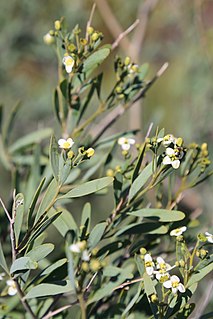
Montinia is a monotypic genus of flowering plants belonging to the family Montiniaceae. It only contains one known species, Montinia caryophyllaceaThunb.
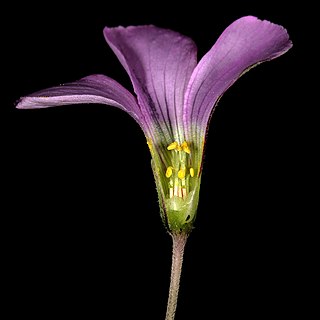
Oxalis bifida is a species of plant. The species was originally described by Carl Peter Thunberg in 1794
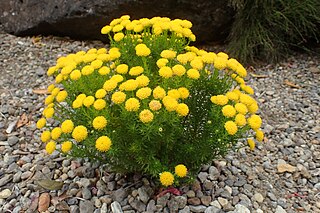
Chrysocoma cernua is a species of flowering plant from the family Asteraceae.
















